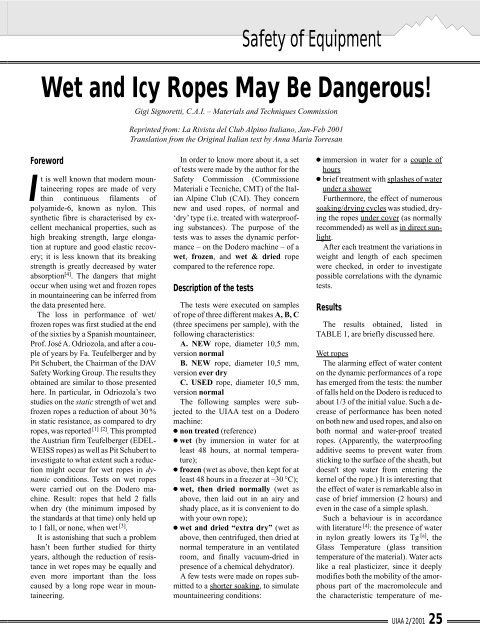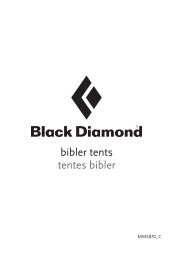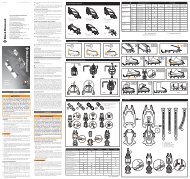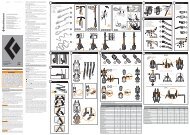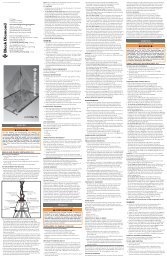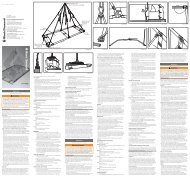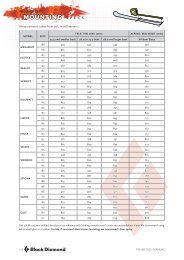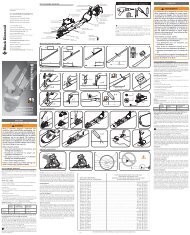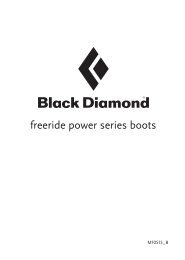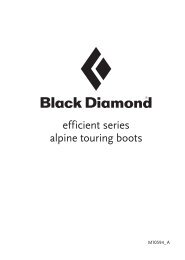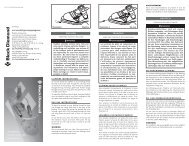Wet and Icy Ropes May Be Dangerous! - Black Diamond
Wet and Icy Ropes May Be Dangerous! - Black Diamond
Wet and Icy Ropes May Be Dangerous! - Black Diamond
Create successful ePaper yourself
Turn your PDF publications into a flip-book with our unique Google optimized e-Paper software.
Safety of Equipment<br />
<strong>Wet</strong> <strong>and</strong> <strong>Icy</strong> <strong>Ropes</strong> <strong>May</strong> <strong>Be</strong> <strong>Dangerous</strong>!<br />
Foreword<br />
It is well known that modern mountaineering<br />
ropes are made of very<br />
thin continuous filaments of<br />
polyamide-6, known as nylon. This<br />
synthetic fibre is characterised by excellent<br />
mechanical properties, such as<br />
high breaking strength, large elongation<br />
at rupture <strong>and</strong> good elastic recovery;<br />
it is less known that its breaking<br />
strength is greatly decreased by water<br />
absorption [4] . The dangers that might<br />
occur when using wet <strong>and</strong> frozen ropes<br />
in mountaineering can be inferred from<br />
the data presented here.<br />
The loss in performance of wet/<br />
frozen ropes was first studied at the end<br />
of the sixties by a Spanish mountaineer,<br />
Prof. José A. Odriozola, <strong>and</strong> after a couple<br />
of years by Fa. Teufelberger <strong>and</strong> by<br />
Pit Schubert, the Chairman of the DAV<br />
Safety Working Group. The results they<br />
obtained are similar to those presented<br />
here. In particular, in Odriozola’s two<br />
studies on the static strength of wet <strong>and</strong><br />
frozen ropes a reduction of about 30 %<br />
in static resistance, as compared to dry<br />
ropes, was reported [1] [2] . This prompted<br />
the Austrian firm Teufelberger (EDEL-<br />
WEISS ropes) as well as Pit Schubert to<br />
investigate to what extent such a reduction<br />
might occur for wet ropes in dynamic<br />
conditions. Tests on wet ropes<br />
were carried out on the Dodero machine.<br />
Result: ropes that held 2 falls<br />
when dry (the minimum imposed by<br />
the st<strong>and</strong>ards at that time) only held up<br />
to 1 fall, or none, when wet [3] .<br />
It is astonishing that such a problem<br />
hasn’t been further studied for thirty<br />
years, although the reduction of resistance<br />
in wet ropes may be equally <strong>and</strong><br />
even more important than the loss<br />
caused by a long rope wear in mountaineering.<br />
Gigi Signoretti, C.A.I. – Materials <strong>and</strong> Techniques Commission<br />
Reprinted from: La Rivista del Club Alpino Italiano, Jan-Feb 2001<br />
Translation from the Original Italian text by Anna Maria Torresan<br />
In order to know more about it, a set<br />
of tests were made by the author for the<br />
Safety Commission (Commissione<br />
Materiali e Tecniche, CMT) of the Italian<br />
Alpine Club (CAI). They concern<br />
new <strong>and</strong> used ropes, of normal <strong>and</strong><br />
‘dry’ type (i.e. treated with waterproofing<br />
substances). The purpose of the<br />
tests was to asses the dynamic performance<br />
– on the Dodero machine – of a<br />
wet, frozen, <strong>and</strong> wet & dried rope<br />
compared to the reference rope.<br />
Description of the tests<br />
The tests were executed on samples<br />
of rope of three different makes A, B, C<br />
(three specimens per sample), with the<br />
following characteristics:<br />
A. NEW rope, diameter 10,5 mm,<br />
version normal<br />
B. NEW rope, diameter 10,5 mm,<br />
version ever dry<br />
C. USED rope, diameter 10,5 mm,<br />
version normal<br />
The following samples were subjected<br />
to the UIAA test on a Dodero<br />
machine:<br />
● non treated (reference)<br />
● wet (by immersion in water for at<br />
least 48 hours, at normal temperature);<br />
● frozen (wet as above, then kept for at<br />
least 48 hours in a freezer at –30 °C);<br />
● wet, then dried normally (wet as<br />
above, then laid out in an airy <strong>and</strong><br />
shady place, as it is convenient to do<br />
with your own rope);<br />
● wet <strong>and</strong> dried “extra dry” (wet as<br />
above, then centrifuged, then dried at<br />
normal temperature in an ventilated<br />
room, <strong>and</strong> finally vacuum-dried in<br />
presence of a chemical dehydrator).<br />
A few tests were made on ropes submitted<br />
to a shorter soaking, to simulate<br />
mountaineering conditions:<br />
● immersion in water for a couple of<br />
hours<br />
● brief treatment with splashes of water<br />
under a shower<br />
Furthermore, the effect of numerous<br />
soaking/drying cycles was studied, drying<br />
the ropes under cover (as normally<br />
recommended) as well as in direct sunlight.<br />
After each treatment the variations in<br />
weight <strong>and</strong> length of each specimen<br />
were checked, in order to investigate<br />
possible correlations with the dynamic<br />
tests.<br />
Results<br />
The results obtained, listed in<br />
TABLE 1, are briefly discussed here.<br />
<strong>Wet</strong> ropes<br />
The alarming effect of water content<br />
on the dynamic performances of a rope<br />
has emerged from the tests: the number<br />
of falls held on the Dodero is reduced to<br />
about 1/3 of the initial value. Such a decrease<br />
of performance has been noted<br />
on both new <strong>and</strong> used ropes, <strong>and</strong> also on<br />
both normal <strong>and</strong> water-proof treated<br />
ropes. (Apparently, the waterproofing<br />
additive seems to prevent water from<br />
sticking to the surface of the sheath, but<br />
doesn't stop water from entering the<br />
kernel of the rope.) It is interesting that<br />
the effect of water is remarkable also in<br />
case of brief immersion (2 hours) <strong>and</strong><br />
even in the case of a simple splash.<br />
Such a behaviour is in accordance<br />
with literature [4] : the presence of water<br />
in nylon greatly lowers its Tg [a] , the<br />
Glass Temperature (glass transition<br />
temperature of the material). Water acts<br />
like a real plasticizer, since it deeply<br />
modifies both the mobility of the amorphous<br />
part of the macromolecule <strong>and</strong><br />
the characteristic temperature of me-<br />
UIAA 2/2001<br />
25
26 UIAA 2/2001<br />
Safety of Equipment<br />
chanical relaxation of the material. This<br />
means that “in many respects, the addition<br />
of water to nylon is equivalent to<br />
raising its temperature by a substantial<br />
amount” (literature). In other words:<br />
testing a wet rope on the Dodero at normal<br />
temperature is about equivalent to<br />
testing the dry rope at 70–80 °C, conditions<br />
which cause a loss in performance.<br />
It has also been noted that the impact<br />
force at the first fall with the wet rope is<br />
significantly larger (5–10 %), as if the<br />
rope had become more rigid than the<br />
dry one. This could be due to increased<br />
fibre-fibre friction as<br />
well as to the increased<br />
length of the<br />
rope. A rope that is already<br />
stretched is indeed<br />
more resistant to<br />
strain, more “rigid”.<br />
The stretching – average<br />
3–5 % – measured<br />
on wet ropes<br />
just after removal<br />
from water is not<br />
negligible compared<br />
to the strain that occurs<br />
in the Dodero<br />
test (30–35 %).<br />
Another unexpected<br />
result: the amount<br />
of water retained by<br />
new ropes is 40–45 %<br />
of the weight of the<br />
dry rope, independent<br />
from the waterproofing<br />
treatment<br />
(maybe the long soaking time – 48<br />
hours – renders the additive ineffective).<br />
In the case of a used rope, the quantity<br />
of water retained is much greater,<br />
about 60 %; this is probably due to absorption<br />
of water caused by the great<br />
quantity of broken filaments existing<br />
on the rope surface.<br />
Frozen ropes<br />
A warning must be made here concerning<br />
the meaning of the tests: it is<br />
not possible to keep the rope icy during<br />
the whole test. This is due to the time<br />
necessary to mount the rope on the Dodero<br />
machine <strong>and</strong> to the long waiting<br />
time required by the st<strong>and</strong>ard testing<br />
procedure (a succession of falls at intervals<br />
of 5 minutes). In addition, the rope<br />
is warmed up by the heat due to the energy<br />
developed at each fall <strong>and</strong> to the<br />
higher ambient temperature. As a consequence,<br />
only during the initial phases<br />
of the test were the ropes frozen. Therefore<br />
the results must be read critically,<br />
trying to extrapolate the results of the<br />
ice-effect from our tests.<br />
In spite of these uncertainties, it can<br />
be stated that the Dodero tests prove<br />
Fig. 1: Correlation between rope diameter <strong>and</strong> residual dynamic strength of wet ropes<br />
that frozen ropes behave slightly better<br />
than wet ropes: there is a smaller reduction<br />
(“only” about 50 %) of the dynamic<br />
performances, <strong>and</strong> even a reduction<br />
(about –10 %) of the impact force<br />
at the first fall.<br />
As a conclusion, we may dare to<br />
guess that if we were able to maintain<br />
the rope frozen during the whole test<br />
the performances of frozen ropes could<br />
be even better, maybe almost as good as<br />
for dry ropes! At low temperature, in<br />
fact, the crystalline structure of the wet<br />
rope, in particular the mobility of its<br />
amorphous part, would be the same as<br />
that of a dry rope at normal temperature.<br />
<strong>Wet</strong> ropes, dried normally<br />
Here is at least one good news for<br />
climbers. After soaking <strong>and</strong> drying, the<br />
ropes seem to regain their characteristics,<br />
as quoted in literature for nylon fibres.<br />
The number of falls on the Dodero<br />
machine reaches its original values,<br />
while the impact force decreases a little,<br />
since the rope is slightly (4%)<br />
shorter.<br />
It is also interesting that the return to<br />
the original performance is granted<br />
even after various cycles<br />
of soaking-drying,<br />
as long as the<br />
ropes are dried in a<br />
cool, airy <strong>and</strong> shady<br />
place. If, however,<br />
they are dried in sunlight<br />
there is a decrease<br />
of performance<br />
at the Dodero<br />
test, due to the negative<br />
effect of the UV<br />
radiation [5] . In our<br />
case the ropes had<br />
been kept in sunlight<br />
for 4 weeks, long<br />
enough to see these<br />
effects.<br />
<strong>Wet</strong> ropes, dried “extra-dry”<br />
These tests confirm<br />
the results reported<br />
above. The complete<br />
drying of the rope reduces its weight of<br />
about 3% compared to the reference<br />
case. This thorough drying process<br />
leads to an almost complete recovery of<br />
the dynamic resistance of the rope – be<br />
it new or used, normal or waterproofed<br />
– <strong>and</strong> to a reduction of the impact force<br />
at the first fall by about 10–12 % (the<br />
rope is about 4–8 % shorter).<br />
Conclusions<br />
The presence of water or ice in climbing<br />
ropes produces important modifications<br />
in their performance, such as:
1. The dynamic resistance of the ropes<br />
(i. e. the number of falls held on the<br />
Dodero) decreases enormously –<br />
down to 30 % of the initial value –<br />
when they are soaked with water, be<br />
they new or used, normal or waterproofed.<br />
2. After soaking in water a rope becomes<br />
4–5 % longer, which can be<br />
correlated to the 5–10 % increase of<br />
the impact force at the first fall on the<br />
Dodero machine.<br />
3. The negative effects of water on the<br />
dynamic performance of ropes are<br />
remarkable even in case of a brief<br />
soaking time, even after being<br />
splashed under a shower.<br />
4. This behaviour seems to be due to<br />
the interaction of water with the<br />
crystal structure of the nylon macromolecule<br />
(according to literature).<br />
5. Such a behaviour lasts as long as the<br />
rope is wet, but after drying – in a<br />
cool, airy <strong>and</strong> shady place, as recommended<br />
– the rope recovers almost<br />
completely its original dynamic performance,<br />
even after various soaking/drying<br />
cycles.<br />
6. Depending on the drying grade (normal<br />
or thorough) the rope can become<br />
shorter by 4 % to 8 %, which<br />
seems to be correlated to the decrease<br />
by 6–12 % of the impact force<br />
at the first fall on the Dodero machine.<br />
7. Even in the case of soaked <strong>and</strong><br />
frozen ropes the dynamic resistance<br />
decreases, but less than in wet ropes.<br />
8. Relationship between residual<br />
strength <strong>and</strong> rope diameter: see Appendix<br />
1<br />
In conclusion, a used rope in good<br />
conditions, say a rope which can still<br />
hold 4–5 falls in the UIAA test on the<br />
Dodero machine when dry, might only<br />
hold 1 or 2 falls when soaked after a<br />
sudden rain fall, as often occurs in the<br />
mountains.<br />
This may not be too much of a serious<br />
problem when climbing in a Klettergarten,<br />
where falls are usually less dangerous<br />
<strong>and</strong> it takes little time to pull the<br />
rope down <strong>and</strong> go home. But mountaineers<br />
must dem<strong>and</strong> the maximum se-<br />
curity from their rope, even when wet,<br />
since it might snap on a rough edge during<br />
a fall. This risk is lower when the<br />
rope is in good condition. The problem<br />
can be less critical when climbing a<br />
glacier or an ice-fall, because the ropes<br />
are frozen, but even in this case the temperature<br />
is very important: if it is goes<br />
over 0 °C, the rope returns to being wet!<br />
In conclusion, it would be a good<br />
idea to change our ropes more often!<br />
Bibliography<br />
[1] Josè A. Odriozola – Estudios previos para<br />
ensayos de cuerdas a baja temperatura –<br />
Revista Peñalara n. 377, abril–junio 1968,<br />
pages 37–40.<br />
[2] Josè A. Odriozola – Comportamiento de<br />
una cuerda de montaña a baja temperatura<br />
– Revista Peñalara n. 380, enero–marzo<br />
1969, pages 14–21.<br />
[3] Pit Schubert – Was halten nasse und<br />
vereiste Seile? – Sicherheitskreis im DAV;<br />
Tätigkeitsbericht, pages 197–206.<br />
[4] Nylon Plastics, edited by Melvin I. Kohan –<br />
Plastics Department, E. I. Du Pot De<br />
Nemours <strong>and</strong> Co., Inc.<br />
Safety of Equipment<br />
[5] Gigi Signoretti – Corde e luce solare – La<br />
Rivista del CAI, Luglio-Agosto 1999,<br />
pages 76–84.<br />
Notes<br />
[a] The Tg, or Glass Temperature, is the glass<br />
transition temperature of the material. Polymers,<br />
as nylon, are made of macromolecules,<br />
where crystal parts (i. e. perfectly orderly<br />
chain structures) alternate casually<br />
with amorphous parts (i. e. disorderly structures<br />
with tangled chains). The temperature<br />
at which the mobility of the amorphous part<br />
is modified is called glass transition temperature<br />
(Tg, Glass Temperature), since the behaviour<br />
of the material is similar to that of<br />
glass (typical amorphous solid) when it is<br />
taken to softening/fusion. The amorphous<br />
part of the material goes from a rigid state to<br />
a plastic state, with greater mobility; generally<br />
all polymers above Tg can be deformed<br />
due to their greater plasticity. It has been<br />
proved that the presence of water in nylon<br />
lowers considerably its glass transition temperature:<br />
according to literature, the Tg of<br />
dry nylon is 60–80 °C, but for wet nylon it<br />
goes down to about 0 °C! This lower Tg in<br />
presence of water means that the mechanical<br />
properties of the nylon filaments of the<br />
rope are strongly modified.<br />
> > > > > > > > > > > > > > > > > > > > > > > > > > > > ><br />
Addition to the mailing list of “World Mountaineering <strong>and</strong> Climbing”<br />
Incorrect address? Moved? No longer interested? New subscription?<br />
Please fill in the following coupon <strong>and</strong> send it to the Editor’s address as given in<br />
the Imprint on page 43:<br />
Tick the box please: New � Change � Delete �<br />
1. Form of address (Mr., Mrs., etc.)<br />
2. First name<br />
3. Surname<br />
4. Position<br />
5. Organisation<br />
6. Street address<br />
7. Post Code<br />
8. City<br />
9. Country<br />
In the case of new subscription, please transfer CHF 30.00 for one year (3 issues)<br />
to the bank acct of the UIAA (see page 43).<br />
Place, Date Signature<br />
✂
Acknowledgements<br />
28 UIAA 2/2001<br />
Safety of Equipment<br />
The author gratefully acknowledges<br />
the collaboration of the Director of the<br />
Laboratory, Department of Constructions,<br />
University of Padova, where the<br />
tests have been carried out. Thanks also<br />
to: Professor Lorenzo Contri, co-ordinator<br />
of the tests; S<strong>and</strong>ro Bavaresco,<br />
who very professionally executed the<br />
Dodero tests; Gianni Bavaresco, who<br />
reported the temperatures during iceclimbing.<br />
Warm thanks are also given by the author<br />
to his colleagues of CAI-CMT Vittorio<br />
<strong>Be</strong>dogni, Giuliano Bressan, Carlo<br />
Zanantoni, <strong>and</strong> in particular to Prof.<br />
Luigi Costa, for their precious advice<br />
<strong>and</strong> suggestions related to this article.<br />
Appendix 1<br />
Correlation between rope diameter <strong>and</strong><br />
residual dynamic strength of wet ropes<br />
The correlation between the effects<br />
of water absorption <strong>and</strong> rope diameter<br />
deserves further investigation, as suggested<br />
by Fig.1. In this Figure the data<br />
concerning our ropes A <strong>and</strong> B are compared<br />
with information kindly provided<br />
by Michel <strong>Be</strong>al. His data refer to three<br />
different types of rope, but suggest that<br />
a curve can be drawn to indicate the improvement<br />
in the strength of wet ropes<br />
with increasing rope diameter.<br />
The agreement between our data <strong>and</strong><br />
<strong>Be</strong>al’s can be considered good, particularly<br />
considering that <strong>Be</strong>al’s soaking<br />
time is much shorter than ours (1 hr instead<br />
of 48 hrs).<br />
This additional information is provided<br />
here not only to suggest that<br />
thicker ropes may be safer in case of<br />
bad weather, but also as a warning to<br />
those who may be wishing to extend the<br />
evaluations discussed in this<br />
paper to other types of rope.<br />
Visit the UIAA webpage:<br />
www.uiaa.ch<br />
Table 1<br />
UIAA TEST ON DODERO MACHINE: BEHAVIOUR OF WET, WET & DRIED AND<br />
FROZEN ROPES<br />
Rope A Rope B Rope C<br />
TREATMENT TEST Normal Everdry Normal<br />
NEW NEW USED<br />
NON TREATED Falls on Dodero No. 8 11 4<br />
(reference) Impact force daN 886 946 950<br />
Falls on Dodero No. 2,3 3 1,5<br />
WET Impact force daN 926 1022 1052<br />
Falls variation –71 % –73 % –62 %<br />
In water Impact force variation +5 % +8 % +11 %<br />
for 48 hours Weight variation +45 % +42 % +59 %<br />
Lenght variation +4 % +2 % +5 %<br />
Falls on Dodero No. 3<br />
WET Impact force daN 984<br />
Soaked Falls variation –73 %<br />
for 2 hours Impact force variation +1 %<br />
Falls on Dodero No. 5<br />
WET Impact force daN 990<br />
With splashes Falls variation –55 %<br />
of water Impact force variation +2 %<br />
Falls on Dodero No. 6 9,4<br />
WET & DRIED Impact force daN 867 812<br />
IN NORMAL Falls variation –25 % –15 %<br />
CONDITIONS Impact force variation –2 % –4 %<br />
Weight variation – –1 %<br />
Lenght variation – –4 %<br />
Falls on Dodero No. 9 10 3<br />
WET & DRIED Impact force daN 785 826 861<br />
IN “EXTRA-DRY” Falls variation +12 % –9 % –25 %<br />
CONDITIONS Impact force variation –11 % –13 % –9 %<br />
Weight variation –3 % –3 % –3 %<br />
Lenght variation –7 % –8 % –3,5 %<br />
4 CYCLES Falls on Dodero No. 12<br />
OF SOAKING Impact force daN 860<br />
AND DRYING Falls variation +9 %<br />
UNDER COVER Impact force variation –7 %<br />
4 CYCLES Falls on Dodero No. 8<br />
OF SOAKING Impact force daN 860<br />
AND DRYING Falls variation –27 %<br />
IN SUNLIGHT Impact force variation –9 %<br />
FROZEN Falls on Dodero No. 4 5 3<br />
<strong>Wet</strong> <strong>and</strong> kept Impact force daN 805 898 819<br />
at –30 °C Falls variation –50 % –64 % –25 %<br />
for 48 hours Impact force variation –9 % –5 % –14 %<br />
Note: these data are the average over three specimens.


